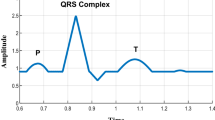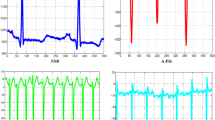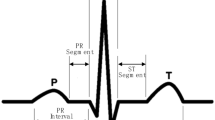Abstract
Feature extraction plays an important role in arrhythmia classification, and successful arrhythmia classification generally depends on ECG feature extraction. This paper proposed a feature extraction method combining traditional approaches and 1D-CNN aiming to find the optimal feature set to improve the accuracy of arrhythmia classification. The proposed method is verified by using the MIT-BIH arrhythmia benchmark database. It is found that the features extracted by 1D-CNN and discrete wavelet transform form the optimal feature set with the average classification accuracy up to 98.35%, which is better than the latest methods.




Similar content being viewed by others
References
Brenyo A, Aktas MK (2014) Review of complementary and alternative medical treatment of arrhythmias. Am J Cardiol 113(5):897–903
Gravina R, Fortino G (2016) Automatic methods for the detection of accelerative cardiac defense response. IEEE Trans Affect Comput 7(3):286–298
Tahir S, Raja MM, Razzaq N, Mirza A, Khan WZ, Kim SW, Zikria YB (2021) Extended Kalman Filter-Based power line interference canceller for electrocardiogram signal. Big Data. https://doi.org/10.1089/big.2021.0043
Uyar A, Gurgen F (2007) Arrhythmia classification using serial fusion of support vector machines and logistic regression. In: 2007 4th IEEE workshop on intelligent data acquisition and advanced computing systems: technology and applications. IEEE
Llamedo M, Martínez JP (2010) Heartbeat classification using feature selection driven by database generalization criteria. IEEE Trans Biomed Eng 58(3):616–625
Bengio Y, Courville A, Vincent P (2013) Representation learning: a review and new perspectives. IEEE Trans Pattern Anal Mach Intell 35(8):1798–1828
Zhang Y et al (2018) PEA: Parallel electrocardiogram-based authentication for smart healthcare systems. J Netw Comput Appl 117:10–16
De Chazal P, O’Dwyer M, Reilly RB (2004) Automatic classification of heartbeats using ECG morphology and heartbeat interval features. IEEE Trans Biomed Eng 51(7):1196–1206
Tateno K, Glass L (2001) Automatic detection of atrial fibrillation using the coefficient of variation and density histograms of RR and ΔRR intervals. Med Biol Eng Compu 39(6):664–671
Lin C-C, Yang C-M (2014) Heartbeat classification using normalized RR intervals and morphological features. Mathe Probl Eng 2014
Zhou Q (2009) The electrocardiogram classification research on electrocardiogram RR interval variation. In: 2009 second international symposium on computational intelligence and design. vol 2. IEEE
Kutlu Y, Kuntalp D (2012) Feature extraction for ECG heartbeats using higher order statistics of WPD coefficients. Comput Methods Programs Biomed 105(3):257–267
Das MK, Ghosh DK, Ari S (2013) Electrocardiogram (ECG) signal classification using s-transform, genetic algorithm and neural network. In: 2013 IEEE 1st international conference on condition assessment techniques in electrical systems (CATCON). IEEE
Uslu E, Bilgin G (2012) Exploiting locality based Fourier transform for ECG signal diagnosis. Int Conf Appl Electr, 323–326.
Raj S, Ray KC (2017) ECG signal analysis using DCT-based DOST and PSO optimized SVM. IEEE Trans Instrum Meas 66(3):470–478
Gumaei A, Al-Rakhami M, Hassan MM, Alamri A, Alhussein M, Razzaque MA, Fortino G (2020) A deep learning-based driver distraction identification framework over edge cloud. Neural Comput Appl, 1–16
Piccialli F, Di Somma V, Giampaolo F, Cuomo S, Fortino G (2021) A survey on deep learning in medicine: Why, how and when? Inf Fus 66:111–137
Liang W, Zhang D, Lei X, Tang M, Li K, Zomaya A (2020) Circuit copyright blockchain: blockchain-based homomorphic encryption for IP circuit protection. In: IEEE transactions on emerging topics in computing, https://doi.org/10.1109/TETC.2020.2993032
Ravì D et al (2016) Deep learning for health informatics. IEEE J Biomed Health informatics 21(1):4–21
Selvanambi R, Natarajan J, Karuppiah M, Islam SH, Hassan MM, Fortino G (2020) Lung cancer prediction using higher-order recurrent neural network based on glowworm swarm optimization. Neural Comput Appl 32(9):4373–4386
Lu W, Hou H, Chu J (2018) Feature fusion for imbalanced ECG data analysis. Biomed Signal Process Control 41:152–160
Li Z, Zhou D, Wan L et al (2020) Heartbeat classification using deep residual convolutional neural network from 2-lead electrocardiogram. J Electrocardiol 58:105–112
Mondejarguerra VM et al. (2019) Heartbeat classification fusing temporal and morphological information of ECGs via ensemble of classifiers. Biomed Signal Process Control
Kiranyaz S, Ince T, Gabbouj M (2015) Real-time patient-specific ECG classification by 1-D convolutional neural networks. IEEE Trans Biomed Eng 63(3):664–675
Golrizkhatami Z, Acan A (2018) ECG classification using three-level fusion of different feature descriptors. Expert Syst Appl 114:54–64
Ye C, Vijaya Kumar BVK, Coimbra MT (2012) Heartbeat classification using morphological and dynamic features of ECG signals. IEEE Trans Biomed Eng 59(10):2930–2941
Prasad GK, Sahambi JS (2003) Classification of ECG arrhythmias using multi-resolution analysis and neural networks. IEEE Region 10 Conf, 227–231
Kim M, Ko H, Pan SB (2019) A study on user recognition using 2D ECG based on ensemble of deep convolutional neural networks. J Ambient Intell Human Comput, 1–9
Ortin S et al. (2019) Automated real-time method for ventricular heartbeat classification. Comput Methods Programs Biomed, 1–8
Martis RJ, Acharya UR, Min LC (2013) ECG beat classification using PCA, LDA, ICA and discrete wavelet transform. Biomed Signal Process Control 8(5):437–448
Strobach P (1995) Single section least squares adaptive notch filter. IEEE Trans Signal Process 43(8):2007–2010
Łȩski J, Henzel N (2005) ECG baseline wander and powerline interference reduction using nonlinear filter bank. Signal Process 85(4):781–793
Barros AK, Mansour A, Ohnishi N (1998) Removing artifacts from electrocardiographic signals using independent components analysis. Neurocomputing 22(1):173–186
Ziarani AK, Konrad A (2002) A nonlinear adaptive method of elimination of power line interference in ECG signals. IEEE Trans Biomed Eng 49(6):540–547
Donoho DL, Johnstone IM (1995) Adapting to unknown smoothness via wavelet shrinkage. J Am Stat Assoc 90(432):1200–1224
Haykin S (2002) Adaptive Filter Theory
Martis RJ et al (2014) Computer aided diagnosis of atrial arrhythmia using dimensionality reduction methods on transform domain representation. Biomed siGnal Process Control 13:295–305
LeCun Y et al (1998) Gradient-based learning applied to document recognition. Proc IEEE 86(11):2278–2324
Scherer D, Müller A, Behnke S (2010) Evaluation of pooling operations in convolutional architectures for object recognition. In: International conference on artificial neural networks. Springer, Berlin, Heidelberg
Ciresan DC et al. (2011) Flexible, high performance convolutional neural networks for image classification. In: Twenty-Second international joint conference on artificial intelligence
Parkhi OM, Vedaldi A, Zisserman A (2015) Deep face recognition. bmvc. vol 1. No. 3
Oh SL et al (2018) Automated diagnosis of arrhythmia using combination of CNN and LSTM techniques with variable length heart beats. Comput Biol Med 102:278–287
Duda, RO, Hart PE, Stork DG (2004) Pattern classification. Pattern classification. Wiley
Wang J-S et al (2013) ECG arrhythmia classification using a probabilistic neural network with a feature reduction method. Neurocomputing 116:38–45
Shoohi LM, Saud JH (2020) Dcgan for handling imbalanced malaria dataset based on over-sampling technique and using cnn. Medico Legal Update 20(1):1079–1085
Vapnik V (1998) Statistical learning theory. Wiley, New York
Zubair, M, Kim J, Yoon C (2016) An automated ECG beat classification system using convolutional neural networks. In: 2016 6th international conference on IT convergence and security (ICITCS). IEEE
Park J, Lee K, Kang K (2013) Arrhythmia detection from heartbeat using k-nearest neighbor classifier. In: 2013 IEEE international conference on bioinformatics and biomedicine. IEEE
Acharya UR et al (2017) A deep convolutional neural network model to classify heartbeats. Computers in Biol Med 89:389–396
Xia Y et al (2018) "An automatic cardiac arrhythmia classification system with wearable electrocardiogram. IEEE Access 6:16529–16538
Zhang Z et al (2014) Heartbeat classification using disease-specific feature selection. Comput Biol Med 46(2014):79–89
Ince T, Kiranyaz S (2009) Gabbouj M (2009) A generic and robust system for automated patient-specific classification of ECG signals. IEEE Trans Biomed Eng 56(5):1415–1426
Zikria YB, Afzal MK, Kim SW, Marin A, Guizani M (2020) Deep learning for intelligent IoT: Opportunities, challenges and solutions. Deep learning for intelligent IoT: Opportunities, challenges and solutions, Computer Communications, vol 164, pp 50–53
Qadri YA, Nauman A, Zikria YB, Vasilakos AV, Kim SW (2020) The future of healthcare internet of things: a survey of emerging technologies. IEEE Commun Surv Tutor 22(2):1121–1167
Islam SM, Lloret J, Zikria YB (2021) Internet of Things (IoT)-based wireless health: enabling technologies and applications. Electr J 10(2):148
Bhavsar KA, Singla J, Al-Otaibi YD, Song O, Zikria YB et al (2021) Medical diagnosis using machine learning: a statistical review. Comput Mater Continua 67(1):107–125
Andreoli A, Gravina R, Giannantonio R, Pierleoni P, Fortino G (2010) SPINE-HRV: A BSN-based toolkit for heart rate variability analysis in the time-domain. Wearable and autonomous biomedical devices and systems for smart environment. Springer, Berlin, Heidelberg, 369–389
Fortino G, Parisi D, Pirrone V, Di Fatta G (2014) BodyCloud: a SaaS approach for community body sensor networks. Futur Gener Comput Syst 35:62–79
Fortino G, Galzarano S, Gravina R, Li W (2015) A framework for collaborative computing and multi-sensor data fusion in body sensor networks. Inf Fus 22:50–70
Gravina R, Alinia P, Ghasemzadeh H, Fortino G (2017) Multi-sensor fusion in body sensor networks: State-of-the-art and research challenges. Inf Fus 35:68–80
Acknowledgements
This work was supported by the King Saud University, Riyadh, Saudi Arabia through Researchers Supporting Project number RSP-2021/18. The work was also supported by the Xiamen science and technology project (3502Z20183047), China Education and research network (NGII20160201), China Postdoctoral Science Foundation (2018M643256), the Fund Project of science and technology development center of the Ministry of Education(2018A01032).
Author information
Authors and Affiliations
Corresponding authors
Ethics declarations
Conflict of interest
The authors declare that the research was conducted in the absence of any commercial or financial relationships that could be construed as a potential conflict of interest.
Additional information
Publisher's Note
Springer Nature remains neutral with regard to jurisdictional claims in published maps and institutional affiliations.
Rights and permissions
About this article
Cite this article
Cui, J., Wang, L., He, X. et al. Deep learning-based multidimensional feature fusion for classification of ECG arrhythmia. Neural Comput & Applic 35, 16073–16087 (2023). https://doi.org/10.1007/s00521-021-06487-5
Received:
Accepted:
Published:
Issue Date:
DOI: https://doi.org/10.1007/s00521-021-06487-5




